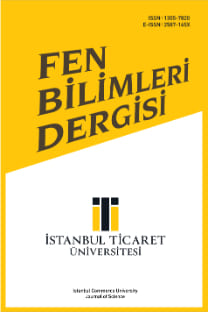POISSON REGRESYON VE EVLİLİK İSTATİSTİKLERİNE UYGULANMASI
Genelleştirilmiş doğrusal modeller, Poisson regresyon modeli, Evlilik
POISSON REGRESSION AND APPLICATION TO MARRIAGE STATISTICS
Generalized linear models, Poisson regression model, Marriage,
___
- Agresti, A. (2015). Foundations of linear and generalized linear models. John Wiley & Sons.
- Altunbaş, O. (2022). Poisson regresyon analizi ve Türkiye’deki evlilik istatistiklerine uygulanması. [Yüksek Lisans Tezi]. İstanbul Ticaret Üniversitesi Fen Bilimleri Enstitüsü. İstanbul.
- Aydemir, E. (2011). Evlilik mi evcilik mi? Erken ve zorla evlilikler: Çocuk gelinler. Uluslararası Stratejik Araştırmalar Kurumu. Uşak.
- Benz, L.S. & Lopez, M.J. (2021). Estimating the change in soccer’s home advantage during the Covid-19 pandemic using bivariate Poisson regression. AStA Advances in Statistical Analysis: A Journal of the German Statistical Society. 1-28.
- Booth, A. & Edwards, J.N. (1985). Age at marriage and marital instability. Journal of Marriage and the Family, 47(1), 67-75. Bumpass, L.L. & Sweet, J.A. (1972). Differentials in marital instability: 1970. American Sociological Review, 37(6), 754-766.
- Cameron, A.C. & Trivedi, P.K. (2013). Regression analysis of count data (Vol.53). Cambridge university press, Cambridge, 598p.
- Consul, P. & Famoye, F. (1992). Generalized Poisson regression model. Communications in Statistics-Theory and Methods, 21(1), 89-109.
- Deniz Başar, Ö. (2005). Poisson regresyon analizi. İstanbul Ticaret Üniversitesi Fen Bilimleri Dergisi, 4(7), 59-72.
- Ercan, U. (2021). Hanehalklarının İletişim ve Bilgi Teknolojilerine Erişimi: Bir Poisson Regresyon Analizi. Akdeniz Iletisim. 35, 402-422.
- Gao, G., Meng, S. & Shi, Y. (2021). Dispersion modelling of outstanding claims with double Poisson regression models. In Insurance Mathematics and Economics November: Part B. 101,572-586.
- Graff, C.A., Coffield, S.R., Chen, Y., Foufoula-Georgiou, E., Randerson, J.T. & Smyth, P. (2020). Forecasting daily wildfire activity using poisson regression. IEEE Transactions on Geoscience and Remote Sensing IEEE Trans. Geosci. Remote Sensing Geoscience and Remote Sensing, IEEE Transactions on. 58(7), 4837-4851.
- İşçi Güneri, Ö., Durmuş, B. & İncekırık, A. (2021). Comparison of some count models in case of excessive zeros: An application. İstanbul Ticaret Üniversitesi Fen Bilimleri Dergisi, 20(40), 247-268.
- Jensen, R. & Thornton, R. (2003). Early female marriage in the developing world. Gender & Development, 11(2), 9-19.
- Kabacoff, R.I. (2015). R in Action (Second Edt.) Data analysis and graphics with R. Manning. Shelter Island.
- Sanizah, A., Hasfariza, F., Rahayu, S.N. & Nasliana, N.N. (2014). Determinants of marital dissolution: A survival analysis approach. International Journal of economics and Statistics, 2, 348-354.
- Thornton, A. (1985). Reciprocal influences of family and religion in a changing world. Journal of Marriage and the Family, 381-394.
- Vicuña, M. I., Vásquez C. & Quiroga B. F. (2021). Forecasting the 2020 COVID-19 Epidemic: A multivariate quasi-poisson regression to model the evolution of new cases in Chile. Frontiers in Public Health, 9, 1-7.
- UNICEF, (2013). Dünya Çocuklarının Durumu 2013 Raporu- Engelli Çocuklar. UNICEF Türkiye. Ankara.
- ISSN: 1305-7820
- Yayın Aralığı: Yılda 2 Sayı
- Başlangıç: 2002
- Yayıncı: Doç. Dr. Necip Şimşek
Nihat Enver ÜLGER, Hümeyra USTA KIRALİ
ÇOK KRİTERLİ KARAR VERME YÖNTEMLERİ İLE TÜRKİYE’DE HES (HİDROELEKTRİK SANTRAL) SEÇİMİ
Münevver TURANLI, Semra ALBAYRAK
XOR VE FAZ/FREKANS DEDEKTÖR PLL İLE MASTER-SLAVE FAZ SENKRONİZASYON METODU
Zeynep KAPLANOĞLU ÇANTI, Serhan YARKAN
GIDA VE YEM İÇİN HIZLI ALARM SİSTEMİ’NDE BULUNAN GIDA İLE TEMAS EDEN MADDE BİLDİRİMLERİ
Aslı YORULMAZ, Ezgi GENÇ, Mehmet Ali CANIMOĞLU, Salih Berkcan ADAK, Ümit ÜNLÜ
BİNA-İÇİ LABORATUVAR ORTAMINDA 33 GHZ'DE BÜYÜK ÖLÇEKLİ YOL KAYBI ANALİZİ
Cihat ŞEKER, Muhammet Tahir GUNESER
OTONOM SİNİR SİSTEMİ VE SEMPATİK AKTİVİTENİN DUYGU DURUMU ÜZERİNDEKİ ETKİLERİNİN DEĞERLENDİRİLMESİ
BİYOFİLİK TASARIM KRİTERLERİNİN MEKANLAR ÜZERİNDEN DEĞERLENDİRİLMESİ
Hazel İrem İRFANOĞLU, Leyla SURİ
BİNA-İÇİ LABORATUVAR ORTAMINDA 33 GHZ'DE BÜYÜK ÖLÇEKLİYOL KAYBI ANALİZİ
Muhammet Tahir GÜNEŞER, Cihat ŞEKER
POISSON REGRESYON VE EVLİLİK İSTATİSTİKLERİNE UYGULANMASI
Özlem DENİZ BAŞAR, Ozan ALTUNBAŞ
Md. Shafinur MURAD, Aybala USTA, Ramazan ASMATULU, Muhammet CEYLAN
